Outwardly jagged and deliberately looking like a big block of clay, the internal shape of the blocks is tulip to give extra-gentle extractions.
Cellarmaster Eleonora Marconi told Canopy: “The tulip shape of the concrete tanks helps with the extraction during alcoholic fermentation. The tulips don’t disperse heat and it’s possible to maintain an average temperature during the slightly higher fermentation.
“Meanwhile during maceration, the temperature stability favours the extraction and evolution of more complex tannic structures.”

The tulip shape, according to Eleonora (above), also aids “the kinetics of juice during alcoholic fermentation” while the unlined concrete allows “a better micro-oxygenation, and reduces the risk of reduction”.
The tanks, designed by the winery’s architects Hikaru Mori and Maurizio Zito, are in a new cave-like cellar carved deep into the blue clay that underpins the famous 6.6ha vineyard. There are also separate barrel rooms for first- and second-year casks, and experiments, as well as areas for bottling, labelling, the wine library and tastings.
With a surface area of 2,500sq m, Masseto’s winery is designed to make it easier for the winemaker to meet the specific demands of each vintage and plot, and to respect the distinctive clay terroir.
Eleonora, who started her winemaking career as an intern at Frescobaldi’s Castello di Nipozzano in 2005, said: “The functional concept for this winery is to work smart. Most of my work is made using the gravity effect from the fill in of the tanks, the wine transfer by gravity without pumping, the fill in of the barriques and so on.”
The advantage, she confirmed, is that the grapes and the wine “are barely stressed by the works inside the winery”.
Previously, Masseto’s ‘Super Tuscan’ was produced next door, in Tenuta dell'Ornellaia’s winery (also part of the Frescobaldi group). There, the fermentation took place in temperature-controlled stainless steel tanks before ageing in medium-toast French oak barrels.
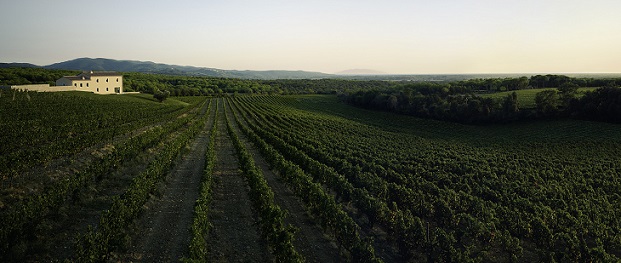
Very little of the winery can be seen above ground – only the grape sorting area and the renovated, historic Masseto House are visible among the organically-farmed vines.
The estate director’s view
“Our winemaking is about reducing the process, reducing intervention…”
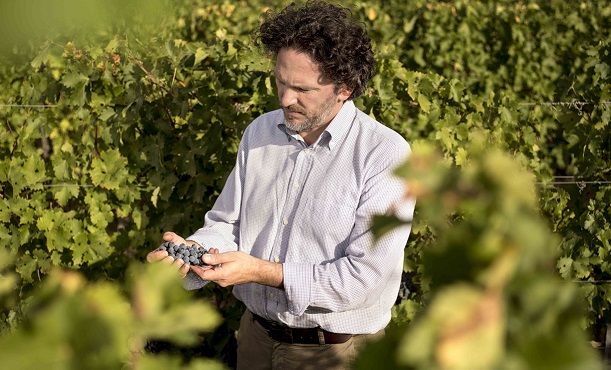
“Our winemaking is about reducing the process, reducing intervention…”
Axel Heinz (above), the estate director, is talking about making wine at Masseto’s new home on the Tuscan coast, close to the small village of Bolgheri.
What remains unchanged, he said, is Masseto’s “less is more philosophy”, carefully developed over the last three decades. “This is all about an amazing, very challenging vineyard. And wine made with great simplicity. We have tanks. We have barrels. We have gravity flow. And we have people who care about the wine. That’s it. That’s our philosophy,” he stated.
Of the audacious architectural design, he said: “Nothing is missing, and there is no more than necessary,”
Axel added that the vivid contrast between the discreet exterior and cave-like interior can be startling for those entering the winery for the first time. But, he said, it’s an experience that mirrors the first sip of Masseto’s Merlot: “So externally restrained and so vast in its internal taste complexity and allure.”
The wine that was never meant to exist
‘Vines need to suffer, but only up to a point’Masseto is a wine “that was never meant to exist,” according to CEO Giovanni Geddes da Filicaja. The potential of the former clay quarry was only spotted in the 1980s by famed oenologist André Tchelistcheff who, against local advice and tradition, recommended planting Merlot in the blue clay.
“The place is very natural, rough, unspoilt. It is quite a tough site,” said Axel. “One would not expect it to be capable of producing this kind of wine. It’s not even the right part of the world for Merlot. It is too extreme. We are always on the edge of making a great wine, and it can go either way. Vines need to suffer, but only up to a point. There is always the risk of failure. But this vineyard always delivers. There’s a real power here and it’s really nature that makes all the important decisions.”
Crucial to that delivery is the patch of million-year-old blue Pliocene clay that lies just beneath the vineyard’s surface. It was once coastal marsh. Over the centuries, the marshland became clay, replete with salt and traces of marine life. As the surrounding hills eroded, it was gradually overlaid by mud, gravel, sand and rock fragments. Earthquakes later pushed those layers into folds, lifting the blue clay away from the sea, bringing it closer to the surface of the Masseto hillside.
The clay’s mineral structure allows it to absorb its own weight in water. It nourishes the vine roots, keeping them cool and always lightly hydrated, even during the hottest summers. Together with the soft coastal breezes, bright sun and quantities of reflected sea light, it provides ideal conditions for the slow ripening of Merlot.
The architect’s view
‘The wines come to life and mature, protected as a child in the mother’s womb’Japanese-born, Milan-based architect Hikaru Mori describes her project this way: “From outside, only the low lines of the grape reception area and the original two-storey house emerge from the hill. There are few external clues to the internal shape. Inside, to represent the effort required to produce the wine made here, we created a series of spaces – not by construction, but by extraction from the hill’s monolithic mass.
“These diverse internal volumes, heights and levels are reminiscent of a gold mine as it follows seams of precious metal to the core. Here, under the sheltering hillside, the wines come to life and mature, protected as a child in the mother’s womb.
“The winery is made from a cast-in-place concrete, to symbolise the solid mass around it. Internally, the different textured and scored surfaces represent the traces left by the extractive process.
“The main entrance to the winery is cut into the hill. A smooth black concrete surface heightens the entrance’s tunnel effect, and a slope leads underground to the winery’s first level. Here, behind a stainless-steel wall, a suspended gallery overlooks the fermentation room with its 12 custom-designed tanks. The deep-grey colour of the tanks and their polyhedral facets create a series of shades and depths.
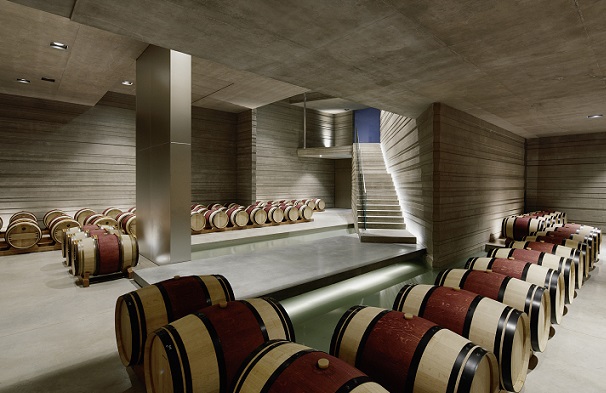
“From here, through a smoked glass wall, the space expands into a second gallery overlooking the first-year barrel room. An excavated staircase leads down to a platform on a water pool. The downward trajectory continues to the centre of the winery: two barrel rooms and the Masseto Caveau, or wine library. The first- and second-year barrel rooms are separated by a burnished-steel sliding door. Here the wine rests, slowly reaching maturity. Throughout the winery, the overhanging and recessed surfaces, along with the irregular shapes of the pillars and walls, all add to the feeling of being inside a quarry.
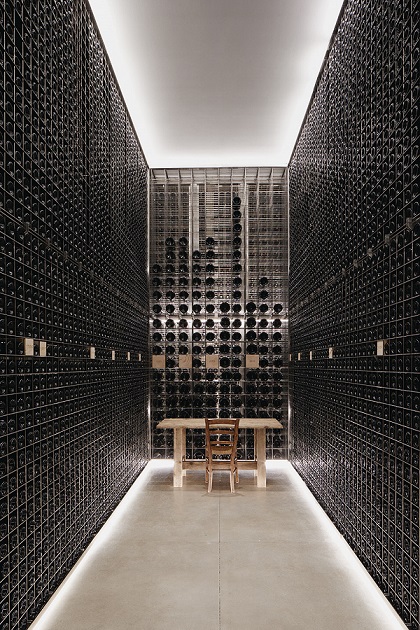
“At one end of the second-year barrel room, there is a partially suspended glass tasting-room. At the other, concealed behind a stone clad wall, is the wine library, Masseto Caveau (above). Bottles from every vintage (from 1986) are preserved here, suspended inside a stainless-steel mesh. Around the barrel rooms and wine library, which are the living heart of the building, lie the technical facilities and vinification process controls.
“Returning to the surface, moving from dark to light, polished concrete steps lead up under the Masseto House. Reconstructed to preserve its historical features, its windows frame the vineyard below, surrounding hills and sea beyond.”
The CEO’s view
Building work began on the winery in June 2016 and was completed in July 2018, with the official opening earlier this year.CEO Giovanni Geddes da Filicaja said the finished project “is a tribute to the past, present and future of Masseto. It celebrates the incredible story of a wine that was never meant to exist.
“Years of planning and effort have been dedicated to building the right home for Masseto. One that consolidates three decades of experience, where every aspect has been designed to meet the winemaking team’s highly detailed requirements.”
Sustainability
- Masseto has been organically farmed since 2012 but, to maintain flexibility and experimental capacity, it has not sought certification.
- The vineyard’s water is purified using biofilters, before it is returned to the soil.
- Gobelet pruning is being tested to see if it increases the vines’ heat and drought tolerance.
- The underground winery is naturally insulated by the blue clay around it, reducing heating and air conditioning needs. When heating is required, the system runs on recycled wood pellets.


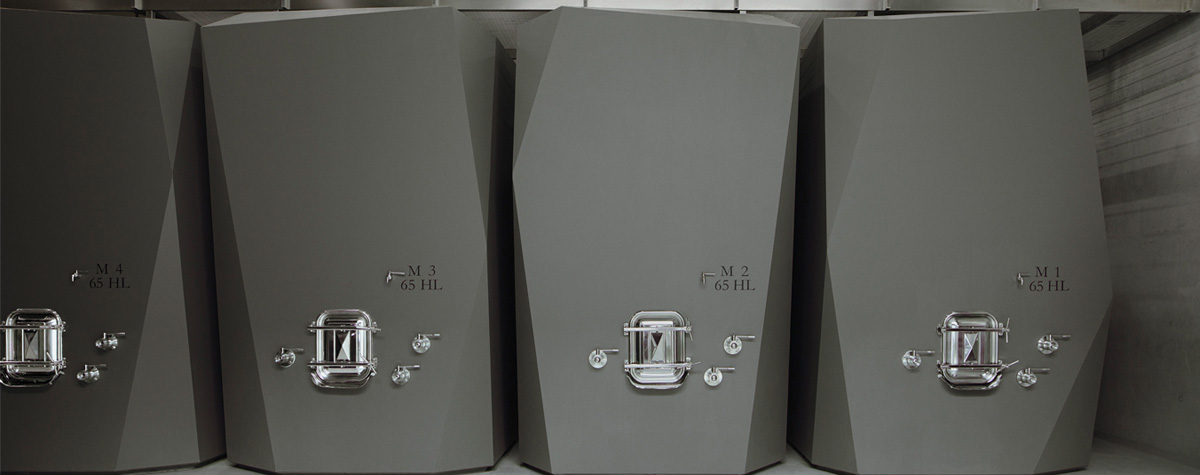










.png)






